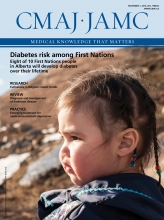A 28-year-old left-handed woman presented to her family doctor with a six-month history of claudication in her left arm associated with pallor, paresthesia and coldness. She could no longer carry out her daily activities. Her arm pain was described as a “heaviness” and worsened with hyperabduction. On examination, the radial pulse disappeared on hyperabduction of her left arm. Chest radiography (Appendix 1, available at www.cmaj.ca/lookup/suppl/doi:10.1503/cmaj.151087/-/DC1) showed prominent bilateral cervical ribs. The severity of her symptoms and findings on physical examination prompted her family physician to order vascular studies (Figure 1) and to initiate referral to a vascular surgeon. Thoracic outlet syndrome, arterial subtype, was diagnosed.
(A, left graphic) Colour Doppler ultrasound of left axillary artery in a 28-year-old woman with claudication; presence of colour and tracing below graphic indicate arterial blood flow. (A, right graphic) Colour Doppler ultrasound of same axillary artery with the patient’s arm abducted at 90 degrees; loss of colour and of tracing indicate loss of blood flow. (B) Photoplethysmograms (PPGs) measuring arterial oxygen saturation in the patient’s right and left hands (represented by left and right graphics, respectively); raising her left arm resulted in loss of tracing.
Thoracic outlet syndrome results from compression involving aspects of the neurovascular bundle (the brachial plexus and the subclavian artery and vein) between the scalene muscles and the first rib.1 Compression of these structures can result in pure neurogenic, vascular (arterial and venous) or a mixed neurovascular syndrome.2 The thoracic outlet can become compressed through hypertrophy of the scalene muscles from repetitive motion or as a result of congenital cervical ribs, as with our patient. Thoracic outlet syndrome may affect people in occupations requiring repetitive upper extremity motion and high-performance athletes, such as swimmers and baseball players.3,4 Provocative manoeuvres during physical examination (e.g., hyperabduction of arms over the patient’s head) may reproduce symptoms.
The American College of Radiology recommends chest radiography to assess for cervical ribs (Appendix 1), and arterial and venous duplex ultrasound of the neck and upper extremity, with provocative manoeuvres to rule out the diagnosis (Figure 1).5 Magnetic resonance angiography is also recommended, but limited access to it may delay timely referral. Small retrospective studies have shown that symptoms resulting from vascular compression often subside after surgical repair to decompress the thoracic outlet, with vessel reconstruction in selected cases.1,3 Neurogenic thoracic outlet syndrome is often associated with poor surgical outcomes because of previous irreversible nerve damage.3 This form of the syndrome should be managed conservatively with behaviour modification (e.g., better workplace ergonomics, reduction of activities involving the arm), physical therapy (e.g., techniques to reduce compression through relaxation of scalene muscles, strengthening of shoulder muscles and improved posture) and analgesia.3 Our patient underwent surgery to decompress the left thoracic outlet through a supraclavicular approach with complete resection of the scalene anterior and medius muscles, cervical rib, first rib and primary repair of an aneurysm in the left subclavian artery; she had complete resolution of her symptoms postoperatively.
Footnotes
Competing interests: None declared.
This article has been peer reviewed.
The authors have obtained patient consent.












